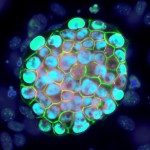Link to Pubmed [PMID] – 11600898
An. Acad. Bras. Cienc. 2001 Sep;73(3):365-83
The ability to introduce genetic modifications in the germ line of complex organisms has been a long-standing goal of those who study developmental biology. In this regard, the mouse, a favorite model for the study of the mammals, is unique: indeed not only is it possible since the late seventies, to add genes to the mouse genome like in several other complex organisms but also to perform gene replacement and modification. This has been made possible via two technological breakthroughs: 1) the isolation and culture of embryonic stem cells (ES), which have the unique ability to colonize all the tissues of an host embryo including its germ line; 2) the development of methods allowing homologous recombination between an incoming DNA and its cognate chromosomal sequence (gene “targeting”). As a result, it has become possible to create mice bearing null mutations in any cloned gene (knock-out mice). Such a possibility has revolutionized the genetic approach of almost all aspects of the biology of the mouse. In recent years, the scope of gene targeting has been widened even more, due to the refinement of the knock-out technology: other types of genetic modifications may now be created, including subtle mutations (point mutations, micro deletions or insertions, etc.) and chromosomal rearrangements such as large deletions, duplications and translocations. Finally, methods have been devised which permit the creation of conditional mutations, allowing the study of gene function throughout the life of an animal, when gene inactivation entails embryonic lethality. In this paper, we present an overview of the methods and scenarios used for the programmed modification of mouse genome, and we underline their enormous interest for the study of mammalian biology.

